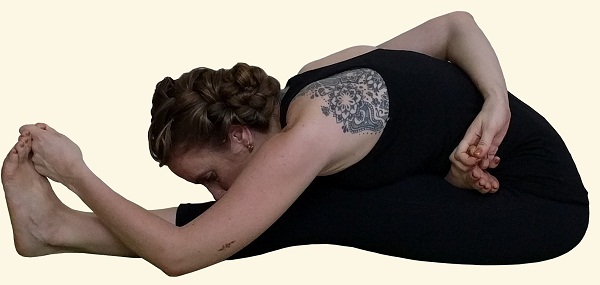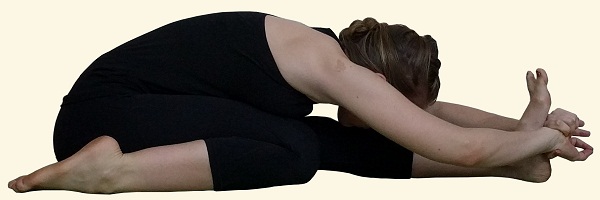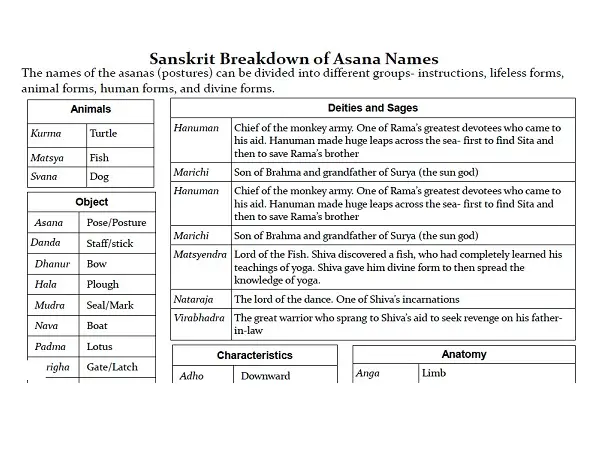The names of the asanas (postures) can be divided into different groups: instructions, lifeless forms, animal forms, human forms, and divine forms.
Instructions
This includes postures like utthita hasta padangushtasana which just means extended hand to big toe posture, telling you what you must physically do to be in the asana.
Lifeless forms
Asanas such as Trikonasana (Triangle Posture) and Navasana (Boat Posture), represent lifeless forms. These tend to occur predominantly in the Primary Series of Ashtanga Vinyasa Yoga.
Animal Forms
The Intermediate Series has more postures named after animals, and some embodiment of the characteristics of that animal are expected along with just the physical shape. Some examples are Shalabasana (Locust Posture), Kapotasana (Pigeon Posture), and Krounchasana (Heron Posture).
Human Forms
There are postures dedicated to the ancient Rishis and the positions in which they are said to have attained enlightenment. Examples are Marichyasana, Bharadvajasana, and Durvasasana.
Divine Forms
Natarajasana (Lord of the Dance Posture), Hanumanasana (Lord Hanuman), and Skandasana (Lord Kartikeya) occur, like those dedicated to Rishis. We see more of these coming in Ashtanga Vinyasa Advanced A or Third Series.
Download the printable one page version as a reference to use anytime you like (especially useful for Yoga teachers or if you want to become one.
Animals
| Kurma | Turtle |
| Matsya | Fish |
| Svana | Dog |
Deiteis and Sages
| Hanuman | Chief of the monkey army. One of Rama’s greatest devotees who came to his aid. Hanuman made huge leaps across the sea- first to find Sita and then to save Rama’s brother |
| Marichi | Son of Brahma and grandfather of Surya (the sun god) |
| Matsyendra | Lord of the Fish. Shiva discovered a fish, who had completely learned his teachings of yoga. Shiva gave him a divine form to then spread the knowledge of yoga. |
| Nataraja | The lord of the dance. One of Shiva’s incarnations |
| Virabhadra | The great warrior who sprang to Shiva’s aid to seek revenge on his father-in-law |
Anatomy
| Anga | Limb |
| Angusta | big toe/thumb |
| Anguli | Fingers |
| Bhuja | Shoulder |
| Garba | Womb |
| Hasta | Hand |
| Janu | Knee |
| Karna | Ear |
| Mukha | Face |
| Pada | Foot/leg |
| Paschima | West (back side of the body) |
| Pinda | Embryo |
| Purva | East (front side of the body) |
| Sarvanga | Whole-body (all limbs) |
| Sava | Corpse |
| Sirsa | Head |
Objects
| Asana | Pose/Posture |
| Danda | Staff/stick |
| Dhanur | Bow |
| Hala | Plough |
| Mudra | Seal/Mark |
| Nava | Boat |
| Padma | Lotus |
| Parigha | Gate/Latch |
| Setu | Bridge |
| Tola | Scales |
| Vriksha | Tree |
Characteristics
| Adho | Downward |
| Ardha | Half |
| Baddha | Bound |
| Kona | Angle |
| Nirlamba | Unsupported |
| Parivrtta | Revolved/Twisted |
| Pida | Pressure |
| Poorna | Full |
| Prasarita | Spread out/Wide |
| Salamba | Supported |
| Samas | Equal |
| Supta | Reclining/Sleeping |
| Uttan | Intense Stretch |
| Utthita | Extended/Lifted |
Numbers
| Ekam | One |
| Dwe | Two |
| Trini | Three |
| Chatvari | Four |
| Pancha | Five |
Using this breakdown you can start to understand and memorize the names of even complicated Asana.
For example
Ardha Baddha Padma Paschimottanasana

Ardha+ Baddha+ Padma+ Paschim+ Uttan+ Asana
(to make the sounds flow better when uttan is joined with other words it becomes ottan.)
Ardha – Half
Baddha – Bound
Padma – Lotus
Pachim – West (Back side of the body)
Uttan – Intense Stretch
Asana – Posture
Another Complicated Posture Name
Trianga Mukkhaikapada Paschimottanasana

Tri+ Anga+ Mukkha+ Eka+ Pada+ Paschim+ Uttan+ Asana
Tri (Trini) – Three
Anga – Limb/Body Part
Mukkha – Face
Eka (Ekam) – One
Pada – Foot
Pachim – West (Back side of the body)
Uttan – Intense Stretch
Asana – Posture
If you see the posture the torso and both arms face the front foot while the other leg is bent back out of the way.
